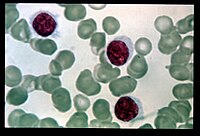
Photo from wikipedia
Hairy cell leukemia (HCL) responds initially very well to chemotherapy with purine analogues. However, up to 50% of patients relapse, often multiple times, and become progressively less sensitive to these… Click to show full abstract
Hairy cell leukemia (HCL) responds initially very well to chemotherapy with purine analogues. However, up to 50% of patients relapse, often multiple times, and become progressively less sensitive to these myelotoxic and immune‐suppressive drugs. At progression, viable therapeutic strategies include addition of rituximab to purine analogues, and treatment with the anti‐CD22 immunotoxin moxetumomab pasudotox, which has been recently approved by the FDA in HCL patients after at least two prior therapies. Identification of the BRAF‐V600E kinase mutation as the genetic cause of HCL has opened the way, in the relapsed/refractory experimental setting, to targeted and non‐myelotoxic effective strategies that are based on inhibition of BRAF with vemurafenib, co‐inhibition of BRAF and its target MEK with dabrafenib and trametinib, and BRAF inhibition with vemurafenib combined with anti‐CD20 immunotherapy. In particular, vemurafenib plus rituximab is emerging as a short, safe, chemotherapy‐free regimen able to induce deep complete remissions in most HCL patients refractory to, or relapsed multiple times, after chemo(immuno)therapy.
Journal Title: Hematological Oncology
Year Published: 2019
Link to full text (if available)
Share on Social Media: Sign Up to like & get
recommendations!